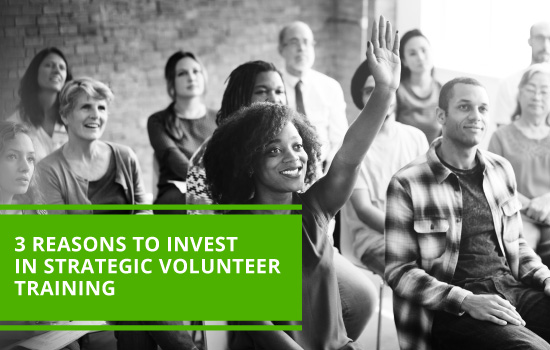3 Reasons to Invest in Strategic Volunteer Training
The best training for volunteers is strategic. This might make sense from a birds-eye view, but what does it mean, exactly, for your cause?
It means that your volunteers are a critical component of your team and that their tireless efforts help you drive your mission forward. It means that without them, you likely wouldn’t be able to sustain effective and cost-efficient operations. It means that your volunteers should be well-equipped with the tools and resources they need to help, and that you should not neglect their training in pursuit of bigger and better things.
At Nonprofit Courses, we work to provide free and low-cost volunteer training programs to set your supporters—and your organization—up for long-term success. In case you’re still not convinced, here are three key reasons to invest in strategic volunteer training:
- Strategic volunteer training creates leaders.
- Strategic volunteer training provides context.
- Strategic volunteer training equips ambassadors.
Are you ready to learn more about the importance of volunteer training programs and the range of benefits they can bring to organizations like yours? Let’s jump in.
1. Strategic volunteer training creates leaders.
Developing a leader in every volunteer is critical. But we’re not talking about top-down command and control leadership. We’re talking about creating independent thinkers, and individuals who lead from within, to make a contribution to your organization that has a broader impact than the role they fulfill.
Like any of us, nonprofit volunteers need to know how they connect to the overall mission objectives of your organization before they’re willing to become leaders—even in the most unofficial sense of the term. But where do you start? Like with anything in your nonprofit, your mission and vision provide an excellent jumping off point.
By way of refresher, your nonprofit’s vision is how you see an ideal world if the problem you address was completely solved. For example, you and millions of people worldwide suffer from the pain, embarrassment, and unhealthy effects of finger hangnails. Just imagine what the world would be like if this scourge was eliminated from human suffering.
Your mission is what you do to eliminate the problem so your vision can be fulfilled. It could be “through awareness and research, you work to save the world from the tragic scourge of finger hangnails.”
How do you fulfill your mission? That’s where your strategic plan comes in. It’s an outline of the big steps your need to take—the research and awareness programs—that will lead to a world (in this case) free of hangnails. When your nonprofit volunteers can see this overarching plan (driven by your vision and mission) they’re more likely to jump at the opportunity to become leaders in your organization.
2. Strategic volunteer training provides context.
Everyone who volunteers for your organization needs to know the big-picture context of their work, and how their work meets your goals—in both the short and long term.
Strategic context makes every job important. Even if a volunteer takes a very small role in your anti-hangnail plan, they feel like they are part of something bigger. This way, even someone who comes in two days a week to distribute free hand lotion bottles on the street can see the value in their function of addressing your objective.
Strategic context is especially important for anyone who is not directly involved in the delivery of mission services—like bookkeeping, for example. Keeping your books is a critical function. It keeps you out of trouble and allows your mission to take place. But if the bookkeeper doesn’t see themselves as part of the bigger plan to meet your important mission, their enthusiasm wanes, and they’ll not be recording your numbers for very long.
But strategic volunteer training is more than inspiration. It’s connecting their role, and therefore their training, into the bigger picture. Strategic volunteer training addresses goals.
For example, anyone can give out hand lotion, right? Perhaps—but is that really all you want them to do? Consider these hypothetical objectives of giving out hand lotion to strangers:
- It fulfills your mission because dried out hands are the number one cause of hangnails, and regular use of hand lotion prevents dried out hands.
- It raises awareness for your organization because most people have never heard of your nonprofit, even though studies show that everyone in their lifetime has suffered from hangnails.
- It leverages corporate partnerships because your deal with a major cosmetic company says that if you can distribute their donated product in three days, you get $10,000. And, if the customer uses the coupon on the bottle to buy more lotion, you get an additional dollar per coupon to go toward your operating expenses.
- It provides volunteers with purpose because they get to partake in all of the above objectives. For example, you find that for every four hours giving out hand lotion, the volunteer gets one inquiry from a recipient because they suffer badly from hangnails, or know someone else who does.
Yes, training a volunteer to smile and give out a hand lotion bottle seems easy, but knowing and communicating why it’s important is empowering. And empowered volunteers take your mission to a new level.
3. Strategic volunteer training equips ambassadors.
With strategic, contextual training, your volunteer becomes more than a smiling face tossing someone a bottle of hand lotion. Providing volunteers with information on why their work is important makes their efforts extra meaningful to them, and to those they encounter on your behalf.
For example, can the volunteer talk about the disease and lack of self-esteem that hangnails can cause? Can they empathize with the sufferer who is ashamed to leave their house because of the condition of their cuticles? Can they discuss the latest-and-greatest research in band-aid technology that will allow the use of touch screen devices with wrapped fingers? By training your volunteer on the bigger picture, they take on the role of ambassador, not just worker.
This goes with any volunteer role in your nonprofit! Everyone who is connected with your organization has the potential to become a strategic ambassador for your mission, whether they intend to or not.
How about when your volunteer bookkeeper’s best friend asks whether the annual Hang-gliding for Hangnails event is worth sponsoring? Of course, the bookkeeper wants to say yes. But is she prepared with all the reasons why?
As your bookkeeper, she should know that your organization’s money is well spent. If, in her professional development as a bookkeeper, she learns the bigger context of the numbers she sees each week, your volunteer will be able to do much more than saying yes or no to her friend. She can talk about the organization’s vision and mission well enough to build enthusiasm in the potential donor for a world without hangnails. She can be a leader to her friend, and in turn, her friend will tell others about your important work.
Volunteers are not easy to find. Then, once you find them, you need to keep them. By investing in strategic, contextual volunteer training through high-quality nonprofit resources, you build enthusiasm for your cause and create leaders who see their role as more than their assignment—for a long time to come. Good luck!
About the Author
 Matt Hugg is an author and instructor in nonprofit management in the US and abroad. He is president and founder of Nonprofit.Courses, an on-demand, eLearning educational resource for nonprofit leaders, staff, board members and volunteers, with hundreds of courses in nearly every aspect of nonprofit work.
Matt Hugg is an author and instructor in nonprofit management in the US and abroad. He is president and founder of Nonprofit.Courses, an on-demand, eLearning educational resource for nonprofit leaders, staff, board members and volunteers, with hundreds of courses in nearly every aspect of nonprofit work.
He’s the author of The Guide to Nonprofit Consulting, and Philanders Family Values, Fun Scenarios for Practical Fundraising Education for Boards, Staff and Volunteers, and a contributing author to The Healthcare Nonprofit: Keys to Effective Management.
Over his 30-year career, Hugg has held positions at the Boy Scouts of America, Lebanon Valley College, the University of Cincinnati, Ursinus College, and the University of the Arts. In these positions, Matt raised thousands of gifts from individuals, foundations, corporations and government entities, and worked with hundreds of volunteers on boards and fundraising committees, in addition to his organizational leadership responsibilities.
